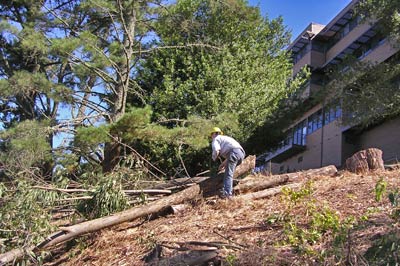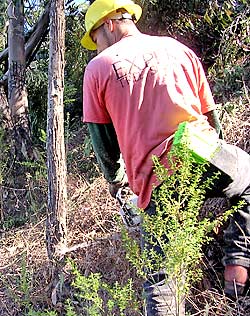UC Berkeley Press Release
 |
A fire abatement crew member works on creating defensible space around buildings Photos by Tom Klatt |
Two UC Berkeley projects in progress to remove fire-hazardous trees from campus property in hills
BERKELEY – Fall is fire abatement time at the University of California, Berkeley, and two projects are underway to remove more than 3,000 non-native trees, the majority of them fire-hazardous eucalyptus, from campus property in the hills.
 A crew member works on reducing the fuel load of non-native vegetation in the hills above the campus |
On Frowning Ridge, which is atop Grizzly Peak and overlooking Strawberry Canyon, UC Berkeley and the City of Oakland this month began a project that includes felling 1,850 blue gum eucalyptus and Monterey pine trees on an 11-acre site to make way for a safer fuel type for the ridgeline – native bay and oak trees with a larger mixture of grasses and shrubs.
And in Claremont Canyon, the campus, in partnership with the Claremont Canyon Conservancy and the City of Oakland, is nearly done felling some 1,000 eucalyptus, pine and acacia trees in its fifth season of a 10-year abatement project that began in 2001. The 3.5-acre site is on the southwest side of Claremont Avenue.
"The forests and the wildlands around the campus are our equivalent of the New Orleans levees," said Tom Klatt, manager of UC Berkeley's Office of Emergency Preparedness. "We need to manage them consistently and persistently. Our work doesn't stop – these projects go on year after year."
In all, UC Berkeley has nearly 1,000 acres of flammable materials that stretch from the Berkeley hills to north Oakland – an area very near the ignition point of the disastrous 1991 Oakland/Berkeley hills fire. The campus aims to remove 50,000 non-native trees by 2014 and create a network of defensible space, safe evacuation routes and fire containment zones to prevent a recurrence of a major firestorm.
Another project, called Upper Strawberry Canyon Phase I, is now finished for the season. At the intersection of Centennial Drive and Grizzly Peak, the campus, along with city of Oakland, removed eucalyptus and pine trees from around the Silver Space Sciences Laboratory and the Mathematical Sciences Research Institute. The work was a pilot project of a major effort, funded by the Federal Emergency Management Agency (FEMA), that will continue through 2009.
That ongoing FEMA project will remove some 9,000-12,000 non-native trees over a 66-acre parcel at a cost of $404,000 and create a fuel break stretching between the Lawrence Berkeley National Laboratory and the Tilden Park Golf Course. The work involves the efforts of several agencies and is expected to be complete within 3-4 years.
Recently, a second campus fire abatement project also was funded by FEMA. It will begin in 2006 and further the Claremont Canyon fuel break. Over the course of three years, the $418,000 effort will include removing 8,000-10,000 non-native trees, primarily re-sprouted eucalyptus, from a 45-acre area on the south-facing slopes of upper Claremont Canyon.
This fall, in both the Frowning Ridge and Claremont Canyon projects, non-native trees are being cut to a height of four inches or less above grade and treated with herbicide to prevent re-sprouting. The felled trees are then chipped and the chips scattered within the work sites. Some of the larger cut trees are stripped of their limbs and branches and placed on the sites for erosion control or as animal habitat.
Eucalyptus trees grow aggressively – up to 15 feet a year – and can reach 200 feet in height. They contain oil that causes them to burn explosively, sparking new fires as flaming pieces of the trees land up to 20 miles away. The trees, native to Australia, were planted as exotic ornamentals in the East Bay beginning in the mid-1850s, primarily by land speculators hoping to attract home buyers to the hills.
Some dense plantations in the hills are remnants of an ill-fated effort to raise the trees as a hardwood crop, which failed due to the characteristics of the trees after milling. Originally, the hills and canyons were covered predominantly with grasses and with bay and oak trees near creeks and swales.
In 1972, a Bay Area freeze appeared to have killed off the eucalyptus trees, but crews didn't tackle the dormant stumps, and shoots soon sprung up. Many of them escaped the 1991 East Bay hills inferno that destroyed 3,400 homes and killed 25 people as it cut a swath down Claremont Canyon as far as Alvarado Road, just above the Claremont Hotel and since have grown into a dense, towering canopy over native trees and plants.
As the campus today is removing non-native trees from fire-prone areas, it also is pulling out other invasive, exotic plants – including pampas grass, cotoneaster, Chilean maytens, German ivy, periwinkle, thistles and broom species – to allow native vegetation to once again prosper in the hills.
"We're the only game in town up there for suppressing invasive plants," said Klatt. "We're trying to do as much as we can to restore the area back to its native state, to control the exotics from taking over. It's part of a broader environmental ethic – we're working to implement a responsible stewardship regime that will succeed over the long-term."
The campus also hopes that by clearing thousands of eucalyptus trees from the hills, native trees that are shorter and slower-growing finally will have room to develop. They include Bay Laurel, oak, redwood, buckeye and madrone and big leaf maple.
Unfortunately, fall fire abatement projects in the hills can be interrupted by dangerous weather for fires. When red flag warnings are given, said Klatt, gas-powered machinery is turned off in fire-prone areas of the project sites so there is no chance of sparks.
"When the wind is over 25 miles per hour," he said, "we suspend operations and move workers to tasks and locations that are not as risky," he said.
But because other seasons of the year are times when workers might cause excess erosion during wet weather or disturb nesting birds or hibernating snakes, the Aug. 1 to Nov. 1 stretch "is our primary window" for abatement projects, said Klatt. He added that the campus is "constantly balancing project mitigation measures with a host of risks and objectives, striving for the best mix to ensure a successful project."
The task of managing the East Bay hills to prevent another deadly fire is a responsibility that will last a lifetime, said Klatt.
"The accumulation of decades of work in vegetation management, coupled with swift and decisive fire suppression, will protect the campus and the surrounding communities," he said. "While future fires are inevitable, the work being done should lessen the severity of fires, and make them smaller and less frequent. We cannot be over prepared for a major wildland fire."
The campus collaborates on fire prevention efforts with other groups including the East Bay Municipal Utilities District; the cities of Oakland, Berkeley and El Cerrito; East Bay Regional Park District; East Bay Municipal Utility District; Lawrence Berkeley National Laboratory; California Department of Forestry and Fire Protection, U.S. Fish and Wildlife Service and the California Department of Fish and Game. The efforts of the cities and the large public landowners are being coordinated through the Hills Emergency Forum, which they formed after the 1991 fire. The forum meets monthly to plan and coordinate the multi-agency work needed to prevent wildfires.

